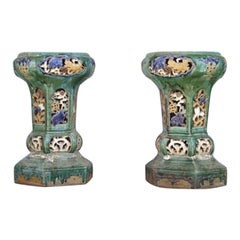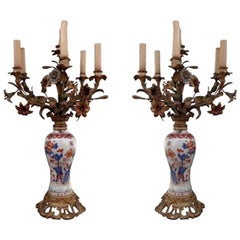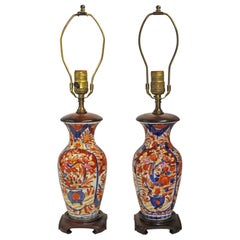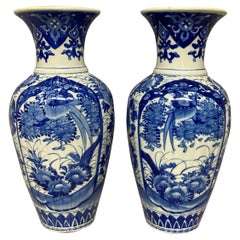MARSEILLE ANTIQUITES Ceramics
to
2
2
2
2
1
2
2
2
2
2
2
1
Pair of 19th Century Chinese Ceramic Bolsters
Located in Marseille, FR
Pair of 19th century Chinese ceramic harnesses. Many chips (see photos). Height 55 cm for a diameter of 38 cm.
Additional information:
Material: earthenware & ceramics.
Category
Antique 19th Century Chinese Ceramics
Materials
Ceramic
$1,189 / set
19th Century Pair of Imari Porcelaine Lamp Mounted Gilt Bronze
By Imari Porcelain
Located in Marseille, FR
19th century pair of porcelain lamp from Imari. Frame gilt bronze decorations of metal polychrome flowers.
Category
Antique 19th Century Chinese Chinese Export Ceramics
Materials
Porcelain
Related Items
C. 1860-80 Pair of Japanese Imari Vases Mounted as Lamps
By Imari Porcelain
Located in Chapel Hill, NC
Circa 1860-80 pair of Japanese Imari vases mounted as lamps. Reeded bodies with large floral reserves with urns. Identical bodies decorated by 2 different artisans. Vases: 9.75" h. 4...
Category
Antique Late 19th Century Japanese Table Lamps
Materials
Porcelain, Wood
Pair Of 19th Century Chinese Blue & White Baluster Vases
Located in Kent, Dover
A pair of good scale late XIX Century Chinese export blue and white baluster vases. Decorated throughout with peonies, peacocks and foliage. I good condition apart from a small histo...
Category
Antique 1880s Chinese Ceramics
Materials
Porcelain
Rare Pair of Satsuma Table Lamps, Japan End of the 19th Century
Located in Paris, FR
Nice pair of Satsuma lamps with black patinated bronze mount.
Gilding is somewhat mitigated locally but they are in very good condition, with no cracks or breakages. Electrical wiri...
Category
Antique Late 19th Century Japanese Table Lamps
Materials
Bronze
$3,805 / set
H 25.2 in W 8.27 in D 7.09 in
Pair of 19th Century Qing Dynasty Faux Bamboo Chinese Vases
Located in Ixelles, BE
Faux bamboo Chinese vases were a type of decorative art that emerged during the Qing Dynasty (1644-1912) in China. These porcelain vases were designed to mimic the appearance of bamboo, a plant highly regarded in Chinese culture for its resilience, elegance, and symbolism. Bamboo is associated with attributes such as flexibility, strength, and modesty, making it a popular motif in Chinese art.
In the Qing Dynasty the color yellow held significant symbolism and represented imperial authority, power, and the emperor himself. Yellow was considered the most sacred and prestigious color in Chinese culture, and it had strong associations with the emperor's position as the Son of Heaven and the ruler of all under heaven.
The marks at the bottom of the vases indicate that these were crafted more specifically during the Tongzhi period – an emperor who reigned from 1861 to 1875, which effectively lasted nthrough his adolescence and was largly overshadowed by the rule of his mother, Empress Dowager Cixi. Although he had little influence over state affairs, the events of his reign gave rise to what historians call the “Tongzhi Restoration”, an unsuccessful modernization program.
The polychrome enamels representing on one vase a traditional Chinese kite...
Category
Antique Late 19th Century Chinese Chinese Export Ceramics
Materials
Porcelain
$2,664 Sale Price / set
20% Off
H 10.44 in Dm 4.34 in
Important Pair Chinese Peacocks 19th Century
Located in Madrid, ES
IMPORTANT CHINESE PEACOCKS 19th Century
Pair of Chinese porcelain sculptures.
polychrome decoration.
Small flaws.
Height: 82 cm.
Good conditions.
Category
Antique 19th Century Chinese Chinese Export Ceramics
Materials
Porcelain
Pair Of 19th Century Chinese Foo Dogs On Stands
Located in Houston, TX
Pair Of 19th Century Chinese Foo Dogs On Stands.
Stunning large pair of antique Chinese beautifully hand decorated glazed ceramic foo dog...
Category
Antique 19th Century Chinese Chinese Export Ceramics
Materials
Ceramic
Antique 19th Century Chinese Mirror Black Porcelain Jar Lamp
Located in Lambertville, NJ
A stunning antique Chinese porcelain 19th century jar, as a lamp. The porcelain jar is in a Mirror black glaze, which is a very dark The Lamp measures 27 inches to the top of the sha...
Category
Antique Mid-19th Century Chinese Chinese Export Table Lamps
Materials
Brass
Associated Pair of 19th Century Chinese Porcelain Mirror Black Lamps
Located in San Francisco, CA
Associated pair of 19th century Chinese porcelain mirror black lamps, circa 1880
Baluster Classic form. Both on old hardwood bases.
Two similar age...
Category
Antique Late 19th Century Chinese Chinese Export Table Lamps
Materials
Porcelain, Hardwood
Pair of Chinese Export Famille Rose Vases, Late 19th Century
Located in Atlanta, GA
This richly decorated pair of porcelain vases exemplifies the ornate style of Chinese export wares from the late Qing dynasty, likely produced in the final quarter of the 19th centur...
Category
Antique 19th Century Chinese Chinese Export Ceramics
Materials
Porcelain
Stunning Pair of Early 19th Century Chinese Export Bronze Mounted Lamps
Located in Lambertville, NJ
A remarkable pair of early 19th century hand painted Rose Mandarin Chinese Export porcelain vases now as lamps. The vases are pre-1850 and lamped i...
Category
Antique Early 19th Century Chinese Chinese Export Table Lamps
Materials
Bronze
$6,850 / set
H 28 in W 6.5 in D 6.5 in
Palatial Pair of Late 19th Century Gilt Bronze Mounted Malachite Candelabra
Located in Long Island City, NY
A Palatial Pair of Late 19th Century Gilt Bronze Mounted Six Light Malachite Candelabra
Finely casted gilt bronze and rococo and foliate arms above a spiraled carved malachite body with bronze handles, supported on thick square bases.
Malachite is a semi-precious stone and also a valuable copper ore, hydrous copper carbonate. It is a beautiful green earth stone...
Category
Antique Late 19th Century French Belle Époque Table Lamps
Materials
Malachite, Bronze, Ormolu
$85,000 / set
H 40 in Dm 16 in
A Chinese Wucai Plate, 19th Century
Located in ARMADALE, VIC
A Chinese Wucai Plate, 19th Century
Home decor, Interior design and collectibles.
Provenance: Private Victoria Collection.
Dimension:
Height: 4cm
Width: 20cm
Depth: 14cm.
Category
Antique 19th Century Chinese Qing Ceramics
Materials
Porcelain



